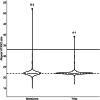Detection of ATXN2 Expansions in an Exome Dataset: An Underdiagnosed Cause of Parkinsonism
- PMID: 37070044
- PMCID: PMC10105108
- DOI: 10.1002/mdc3.13699
Detection of ATXN2 Expansions in an Exome Dataset: An Underdiagnosed Cause of Parkinsonism
Abstract
Background: CAG-repeat expansions in Ataxin 2 (ATXN2) are known to cause spinocerebellar ataxia type 2 (SCA2), but CAA interrupted expansions may also result in autosomal dominant Parkinson's disease (AD PD). However, because of technical limitations, such expansions are not explored in whole exome sequencing (WES) data.
Objectives: To identify ATXN2 expansions using WES data from PD cases.
Methods: We explored WES data from a cohort of 477 index cases with PD using ExpansionHunter (Illumina DRAGEN Bio-IT Platform, San Diego, CA). Putative expansions were confirmed by combining polymerase chain reaction and fragment length analysis followed by sub-cloning and sequencing methods.
Results: Using ExpansionHunter, we identified three patients from two families with AD PD carrying either ATXN2 22/39 or 22/37 repeats, both interrupted by four CAA repeats.
Conclusion: These findings demonstrate the usefulness of WES to detect pathogenic CAG repeat expansions, which were found in 1.7% of AD PD in the ATXN2 gene in our exome dataset.
Keywords: ATXN2 gene; CAA interruption; Parkinson's disease; repeat expansions; whole exome sequencing.
© 2023 The Authors. Movement Disorders Clinical Practice published by Wiley Periodicals LLC on behalf of International Parkinson and Movement Disorder Society.
Figures


References
LinkOut - more resources
Full Text Sources
Research Materials

